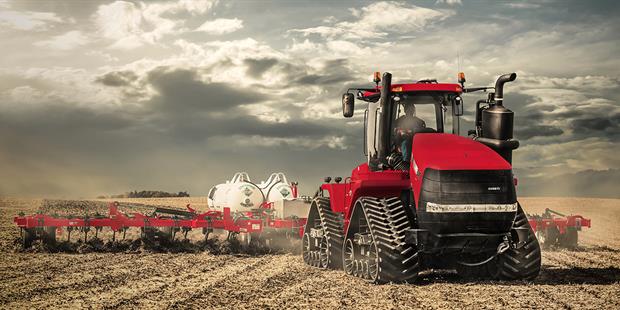Case IH: The management of the routes of the agricultural vehicles in the field, key to reduce the compaction
Systems to reduce traffic do not have to be rigid / Crawler tractors and combines minimize the amplitude of the traffic terrain / Case IH’s RTK + network offers maximum coverage and transcends borders / The new AccuTurn Pro with RTK guidance automates the guidance at the end of the row and the management of turns in header in a single function.
Given that the first pass of a vehicle through the field generates the greatest compaction of the soil, any form of restricting the passage through that area in subsequent operations could considerably limit the degradation of the structure of the land – and it does not have to be difficult or expensive.
This was the message of Ian Beecher-Jones, the precision agriculture specialist invited to the Case IH press conference held near Dresden (Germany) and in which the brand presented all its novelties for 2019 to the European press. Ian Beecher-Jones, who runs a global consulting firm aimed at advising farmers and manufacturers on how to maximize the value of precision equipment, defined some of the measures that farmers can adopt to reduce soil compaction, how to assess the problems existing and how to correct them. Small improvements in management practices can have a big impact on cost savings, as suggested by Beecher-Jones.
“Really the type of soil is irrelevant, since everyone is affected in one way or another their physical and chemical properties as a result of agricultural use. What is really important and what the studies have been able to quantify is the significant increase in the average yield of the crop and the cost savings achieved by less soil compaction when applying controlled traffic techniques, that is, by reducing the traffic of vehicles in field”.
It’s better to prevent than to cure
It is preferable and less expensive to prevent the formation of compaction than to mitigate it, according to Beecher-Jones.
“To solve problems in the field and maintain its structure, both natural and mechanical means can be useful. Encouraging earthworm populations and using cover crops are examples of natural remedies. Regarding the mechanical means, self-guided RTK signal systems with a reproducible precision of 2.5 cm allow to reduce the level of terrain transited within the fields without it having to be a complex process that requires large additional investments “.
Farmers who work or are considering working with self-guided systems based on RTK have in their hands a technology that allows them to reduce transit areas without having to invest in implements of an adequate width, according to the expert.
“Agriculture with totally controlled traffic (Controlled Traffic Farming or, in its abbreviations in English, CTF), in which the machines use year after year the same roads to transit through the field, is not always possible in all fields, and the term ‘managed’ traffic may define the concept better than the term ‘controlled’. It is necessary to take into account how factors such as the type of soil and the slope of the field can affect the compaction and the need for correction. The convenient use of appropriate implements and adjusted correctly in the right conditions will reduce the formation of compaction in all types of tillage systems.
Do not be afraid to be flexible
Farmers should consider the best way to work in a field to reduce traffic, especially when harvesting and transporting the crop. However, at other times of the year, you should not be afraid to be flexible to reduce traffic with the most practical solution that best suits your system. If in some years – for example, in a wet season or when you have a crop that can not be combined in rotation – it is not possible to follow exactly the previous lines, the world does not end. Reducing traffic as much as possible over time will continue to provide great benefits. ”
“The same thing happens if you need to work the ground in an inclined position or plow it to bury weed seeds or restructure the soil,” said Beecher-Jones. These processes could be a step back for controlled traffic but, if they are needed to improve agronomy, farmers should not be afraid.
“The fundamental thing is that, whatever the operation, the traffic at that moment is minimized. In addition to following the same routes where possible, the impact on these routes must be taken into account. Could the weight of the machinery be better distributed using tires with a longer and narrow contact surface? Do the tires have the best?
pressure for the task to be done? Has the tractor been properly weighted down to reduce wheel slippage? Are the caterpillars a better option according to the type of soil and the work circumstances? And is it feasible to modify the track widths of the tractors of a farm to match as much as possible? Any marginal advantage will be beneficial. ”
Finally, the collection process has a significant effect on the land throughout the following year, according to this specialist. The study of yield maps may indicate some correlation between areas of low yield and areas of soil compaction, but harvesting techniques themselves may also have a large negative impact on the soil facing the next crop.
“A complete CTF system is not necessary to ensure careful positioning of the tractors during loading. In this sense, the discharge augers can be useful, offering an extra reach with their final pieces. And it must be borne in mind that units with front-wheel-drive tracks could keep the weight of the combine itself within smaller and narrower bands. Finally, if a harvester does not have to be replaced soon, but its working width does not adapt to the reduced traffic plan, it could be considered to replace only the head as a relatively cheaper option for those seeking more immediate results. ”
Case IH controlled traffic solutions: new AccuTurn Pro, RTK + coverage that transcends national borders, vehicle technology with caterpillars
Hans-Werner Eder, Product Marketing Manager of Case IH for EMEA, suggested that when considering investing in technology to reduce compaction, farmers should carefully examine the consistency of coverage provided by signal providers, as well as as the measures in case of loss of signal and the ability to connect rows or curves by automated guidance at the end of the row.
“We continue to develop the European RTK + network of Case IH to ensure that customers using our AccuGuide autoguiding systems benefit from the most uninterrupted signal coverage possible, with the help of our xFill technology that builds bridges in the unlikely event of a loss of signal, “he explained.
“The RTK + network currently covers 979 base stations that offer the consistent coverage needed for customers to fully take advantage of the 2.5 cm RTK accuracy and reproducibility in all areas in order to reduce travel and compaction. As farms are growing and – for example, on the European continent – they often cross national borders, very few can offer this extension of uninterrupted coverage at a pan-European level. ”
The capacity of the Case IH tractors to reduce the damage to the ground is extended with the introduction of the AccuTurn Pro for the next season, which brings the advantages of RTK reproducibility of 2.5 cm to the turns at the head / end of the row .
“This new development, available on all Case IH tractors with AccuGuide autoguiding that use an RTK signal, combines the advantages of tractor / implement automation by managing turns in the HMC II header with those of the RTK autoguide in the next pass for limit the compaction in the header and control the journeys “.
When evaluating the replacement of main harvesters and tractors, Eder also encouraged farmers to consider whether they have the most suitable propulsion systems for their soils and their specific circumstances.
“The advantages of distributing the weight of the harvesters on long contact surfaces instead of wide ones to reduce the traffic area have been evident thanks to the success of the Axial-Flow caterpillars, while the widths of the heads and the lengths of The discharge augers on all models have been designed to control the traffic of the field.
With the Quadtrac, the benefits of an articulated design of four caterpillars compared to two caterpillars with differential steering have been proven for more than two decades. The Magnum Rowtrac has made it clear that it is possible to benefit from the traction of the tracks in a smaller unit without resorting to differential steering. And all are available with the simple Case IH AccuGuide system with RTK guidance to obtain the necessary reproducibility in order to reduce the transited terrain and achieve a rapid return on investment. ”






